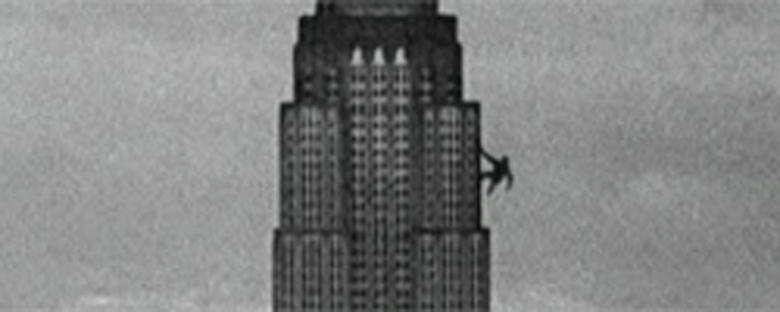Reviews
Merian C. Cooper and Ernest B. Schoedsack
USA, 1933
Credits
Review by Rumsey Taylor
Posted on 29 November 2005
Source Warner Bros. DVD
Related articles
Reviews: The Most Dangerous Game
Roughly the first third of King Kong is devoted to exposition: a hubristic filmmaker, his hasty casting of a naïve, beautiful woman to star in his film, his exploitation of a Pacific island tribe, and the sinister presence of something on the natives’ island. This third is told forcibly and with haste, in melodramatic dialogue and weak staging comparative to the spectacle that is to come. It elicits little critical scrutiny because it’s essentially useless; King Kong begins once the eponymous gorilla towers over the woman that will enable his demise.
The remainder of the film is a magnificent assembly of visual highlights, culminating, some seventy minutes later, with the beast atop the Empire State Building and his beauty in tow, encouraging a team of fighter aircraft to take aim. This image demonstrates the futility of the beast’s plight, and also the film’s pinnacle contrivance, a climax without regard to reason or logistics. Note that Kong scales the skyscraper with his one free hand, but foremost, the matter of the beast’s sedation and transportation to New York is omitted entirely.
King Kong is rightfully considered an early milestone in film, but it is a masterpiece of artifice. Film is an agent of imagination, and King Kong demonstrates this with remarkable technical proficiency and innovation, but also with little maturity and wit. Evaluating the film as a romance — as it clearly intends to be seen — is contingent upon understanding Kong’s attraction to a human woman. The woman’s beauty is obvious to you, but Kong’s perception of this beauty is immediate and under-developed. Despite his awesome stature, Kong is doomed because he inherits the flaws of man. If his intention is to keep his beauty, then he is as hubristic as the filmmaker that arranges his imprisonment.
The film’s greatest potential is as a parable for American imperialism. This aspect is merely apparent in the film’s periphery—the narrative favors the more presumably understood love story, but this formula is hindered by its lack of feasibility. After having saved his diminutive love interest from a throng of crewmen (who are attempting to rescue her) and a Tyrannosaur, he handles his incapacitated love close to his face, removes parts of her clothing, and smells her body. (This scene was censored in early distributions of the film.) It is the only scene in which this inordinance is confirmed. Kong may do nothing but observe his love, and his realization of this inability is as tragic as his epic death.
We are to think Kong’s perception of beauty is acute. In search of his misplaced love, during his final rampage, the behemoth reaches into an apartment window, procures its female tenant, whom he tosses below because she does not meet his specific evaluation of beauty. Once he does find his desired woman, there is nothing he can do with her. And once this flaw is confirmed in an otherwise impervious beast, his downfall is instigated.
We don’t do comments anymore, but you may contact us here or find us on Twitter or Facebook.



